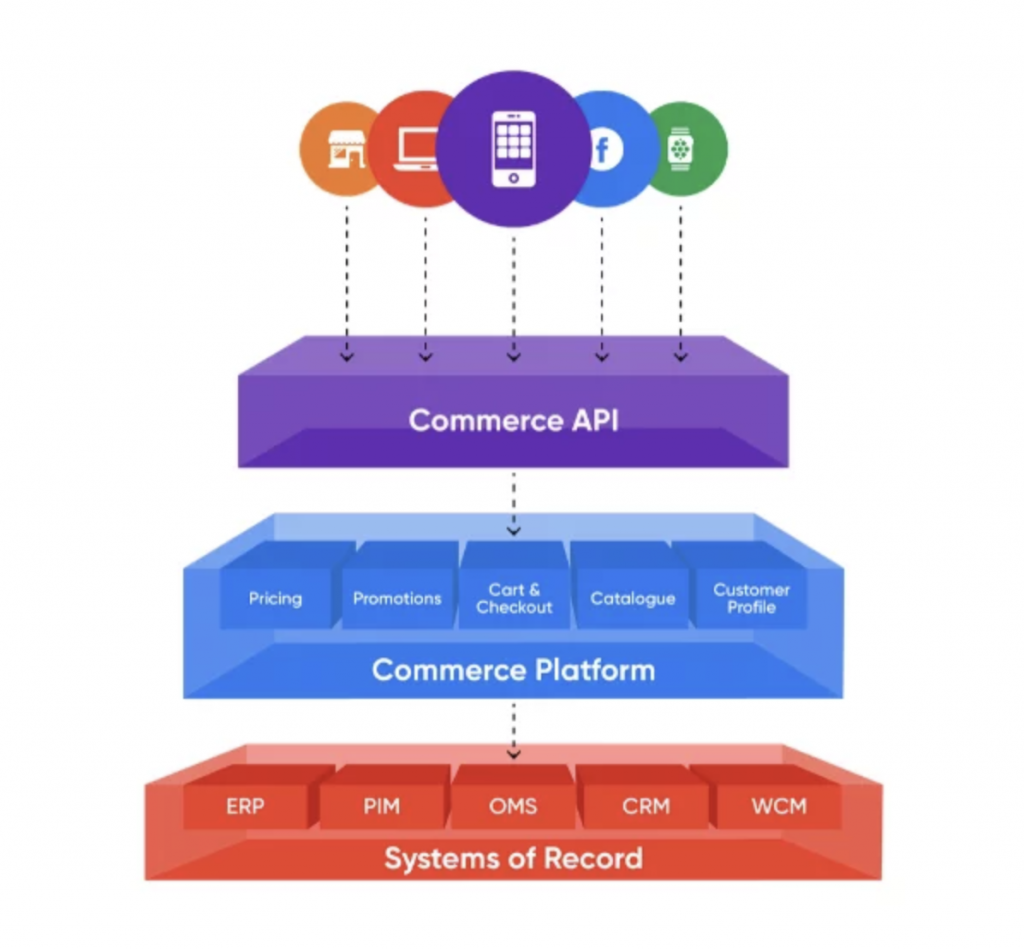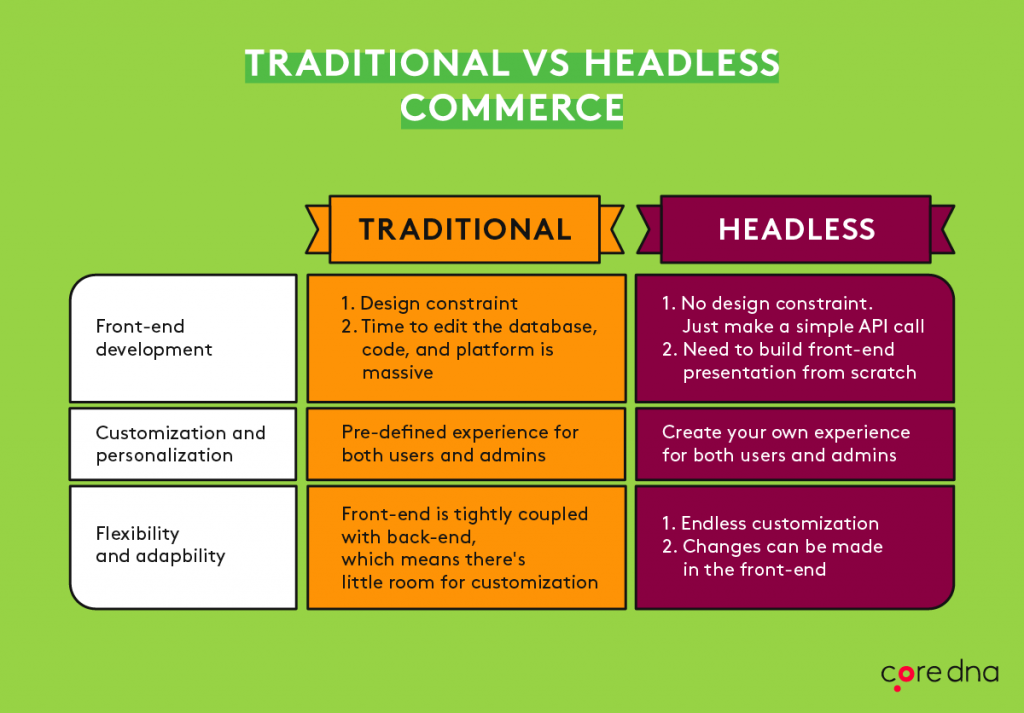
Headless commerce is about a different way of coordinating development activities. Traditionally, there is a front end and back end, and these two are coordinated to produce a great result. With the headless approach, the frontend presentation (head) has been decoupled from the backend commerce functionality. This means that the user interface, social commerce, and digital marketplace might be updated individually, without changing the backend accordingly. Magento uses it too, but it needs ecommerce security features to be used.

What is Headless Commerce
To put it simply, headless ecommerce is the separation of the front end and the back end of the ecommerce application. This separation gives businesses the freedom to build whatever they want and need to build. This enriches the experience of businesses and also the experience of customers as soon as it gives a new unique experience to customers. Headless ecommerce decisions never come out of the box, which means they are always custom, and thus unique in their ideas.
Practically, headless ecommerce is a trend that needs to be followed as soon as the ecommerce developers need to follow all trends quickly to pace up with the market. Generally, Headless gives new opportunities to be noted on the market as a unique ecommerce project. The adopters of headless ecommerce are usually big companies that use the DIY approach to their business, which means a custom individualized approach. Thus, these solutions are so popular among Top eCommerce web design companies. On top of that, headless ecommerce does need more time and effort than a traditional approach.
Headless Ecommerce vs Traditional Ecommerce
Interestingly, the main difference between headless ecommerce and traditional ecommerce is the architecture. In headless ecommerce, architecture is designed to fit into the world of the IoT. While the main idea is that the headless ecommerce combines the benefits of the front end and back end development, the disadvantages are combined as well. Therefore, to be able to use headless ecommerce to the best of its potential, there is a need to make sure that the employees are motivated and adopted well, and they have all the right tools to succeed in development. When the resources are allocated and applied well, the main benefit of ecommerce, that is the timely development of new features is going to really benefit the business.
In other words, when used appropriately, headless ecommerce is going to make the online store unique because it helps to avoid the tight front-end pre-designed for a certain use. With the traditional development, the code and appearance are generally customized, and the content is delivered on the platform specified for the digital use and the native mobile apps. When the traditional eCommerce is aimed at the functioning of the API, the headless ecommerce is based on the RESTful API that has a back-end data model and a could-based infrastructure. Generally, thanks to the flexibility, headless ecommerce can deliver things like content and products in a way that is well-suited for smartwatches, various other smart devices, and kiosk screens.

In general, the difference between Headless and Traditional eCommerce is based on development processes. More specifically, traditional development processes in eCommerce are connected with a number of restrictions, and when there is a need to change something, there is a need to change the entire complex of the database, the code, and the front-end platform. In addition, the traditional approach offers a traditional design and approach for the user experience while headless ecommerce offers a variety of unique experiences. With headless platforms, the user experience is totally shaped by developers. With the traditional approach, any unique change is going to be a long process. On the contrary, with Headless, any change, whether big or small is going to be quick to make.
Benefits of Headless Ecommerce
With the use of headless commerce, developers are going to provide better customer experience and omnichannel shopping because the main advantage of such an approach is an opportunity to develop individual templates or themes. With headless ecommerce, businesses can find their customers using banner ads, videos, voice, and even more with the aim to deliver a competitive advantage of meeting customers exactly where they are.
Headless commerce grants flexibility with customization and experimentation
With no separation of back-end and front end, the headless commerce environment, design teams can create different user interfaces and experiment with the features and optimization on the project.
Headless commerce makes integrations faster
Traditionally, updates and integrations are a long story because they require several weeks to be implemented. With headless commerce, integrations are API driven, which means much faster integrations. With the headless approach, software platforms such as CMS, CRM, ERPs, and others can be integrated really fast.

Disadvantages of Headless Ecommerce
Management and Technical Maintenance
The headless ecommerce development is a more complex system and it often requires custom code to be written. In other words, standard features have to be re-coded to work well with the headless ecommerce system. With all benefits of the ecommerce system, it is not ready to work out of the box as a traditional system. It needs customization instead. As soon as the system needs a lot of customization, and it is flexible, the system needs continuous technical maintenance.
No Continuous Updates
Headless systems lack the benefit of continuous updates. While traditional systems are updated through the update of the API, such an approach does not work with the headless system. No upgrades can be very time-consuming and cost-consuming when it comes to security because there are no systematic updates rolled out for the headless system.
Headless Ecommerce Platforms
Headless ecommerce is in the development phase but there are already enough ecommerce platforms that offer APIs facilitating a headless approach to ecommerce. The platforms that work with Headless ecommerce include Magento 2, Shopify Plus, and Core DNA. Magento is one of the most popular and easy to use platforms for Headless. The ecommerce projects on Magento 2 include but are not limited to:
- - Oliver Bonas – Magento + Angular.js front-end that is a popular retailer selling accessories, gift, and home items.
- - Big Green Egg – Magento + custom JS front-end is the popular grill and appliances retailer
- - Harts of Stur – Magento + Deity (PWA) - is an online store selling food items and kitchen appliances. The range of the items on sale is really vast but still, the store functions greatly with Headless technology on Magento.



So, practically, when deciding for or against the headless ecommerce development, there is a need to choose between flexibility and lots of features of the headless development and security and the ease of maintenance of the traditional solution. More specifically, ongoing costs for maintenance of the headless ecommerce solution are going to be greater than that of the traditional solution. However, such a solution is going to be very important for the owners of multiple-store ecommerce businesses. Therefore, for each project, there is a need to pick the solution individually.
Need help in Headless Ecommerce Development?
All of this sounds complicated, huh?
If you need more information about headless ecommerce development, just drop us a line. We’ll be happy to provide you with a consultation or a free project estimate.



